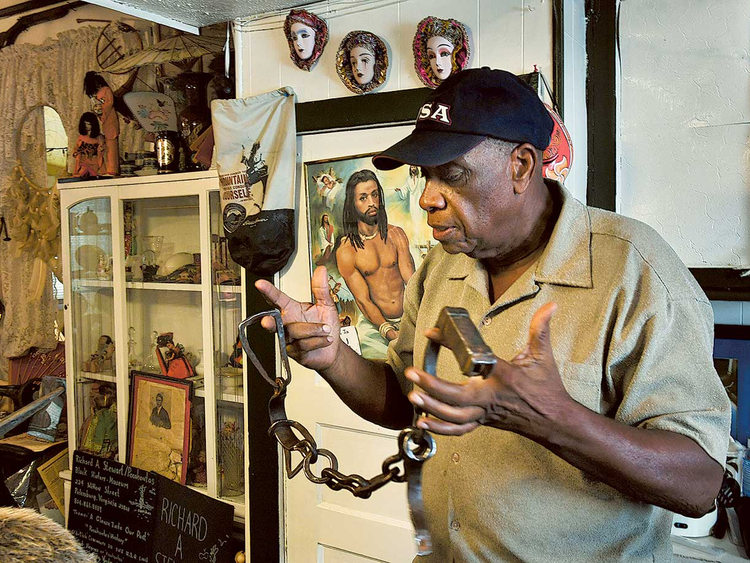
Pocahontas Island: He roams from house to house along the quiet streets of this little neighbourhood, giving voice to its history and spirits.
In Richard Stewart’s eyes, Pocahontas Island is alive with an unexpectedly dramatic past. Using a black magic marker, Stewart scrawls the words of 12 generations of ancestors on old porch rails, doorways and window frames.
Pocahontas Island — 70 acres in the middle of the Appomattox River next to downtown Petersburg — is home to one of the oldest African-American communities in the United States. Pocahontas became a town in 1752, a centre of tobacco trade and, later, shipping and railroads. White people lived here, too, but the community always had African-Americans at its heart.
“The richness of the soil and its history — can’t no money replace that. This is my holy land,” Stewart said. “This is my place.”
A retired federal worker, Stewart, 72, has used his pension and a little family money to buy several properties on Pocahontas Island and create a homespun historical park. It’s solitary, back-breaking work. He cuts the grass, patches walls, even reframes collapsed roofs. He installed a Black History Museum in one of his houses, and he painted the others in eye-catching colors, festooning them with flags to catch attention.
Pocahontas Island is significant not just because it’s old, but for its connections to the Revolutionary War, the slave rebellions of the early 1800s, the Underground Railroad and the Civil War.
“You may have a museum in Washington, D.C.,” Stewart said, “but we are on natural ground. We are on land where slaves walked, where abolitionists walked. This is our native land.”
Stewart grew up here when it was still full of life, and he swam in the river and played Civil War in the woods. He was orphaned by age 16, but others on the island looked out for him. He left to work for the military and civil service, but always came back. As the neighbors got older, some gave him discounts to buy their property, with the understanding that he would take care of it. So, it became his life’s work.
And along the way, he absorbed stories.
Slaves and free blacks lived side by side on Pocahontas Island, which was a port on the Appomattox before joining the city of Petersburg. It became an island after a canal was built in the late 1700s. Today, it’s more of a peninsula, as the main channel of the river clogged after a flood in the early 1970s.
Petersburg was one of the busiest slave markets in the old South, but it also had one of the highest concentrations of free blacks, attracted by jobs and by the presence of a community of their own. For a time, in the spirit of liberty after the Revolutionary War, a few planters freed their slaves.
And Pocahontas Island was where many went to live. That means history has played out here from an African American point of view from before the Revolution until today.
“It is an active African American community that has direct ties to that period of not only Petersburg but Virginia history, and by extension the nation’s history,” said Louis Malon of the nonprofit Preservation Virginia, which plans to catalog sites on the island beginning this month. In 2014, the organization listed Pocahontas Island as one of the most endangered historic sites in the state.
Fifty houses and a chapel
About 50 houses, one chapel and a community center are laid out on five streets. The population is down to roughly 60 people, from a high of several hundred in the mid-20th century, and all the stores and businesses are gone. The only brick building is the Jarrett House, built in 1810 and once home to a free black woman and her children. The city of Petersburg bought it and has stabilized it, but is mired in budget woes, so restoration is on hold.
Richmond writer and entrepreneur Free Egunfemi discovered Pocahontas Island when researching her family’s history, and has become a passionate advocate, writing articles in a local news blog.
“It is a place,” Egunfemi said, “of self-reliance and black freedom.”
The rooms of Stewart’s history museum are crammed with too much for the eye to take in. He has slave shackles, countless pictures and artifacts dug up from nearby yards: a doll’s head, iron locks, bottles, shells. The 1860 sheet music for the “Virginia Polka” by Tom the Blind Negro Boy Pianist sits next to a one-year contract to hire a slave in 1836. And all of it is papered with hand-lettered signs, some listing rolls of blacks who fought in the Revolution or even for the Confederacy.
Stewart’s stories have a way of making a troubling past seem disconcertingly close. And to Stewart, it is.
When he looks at the issues of today - racial tensions, police shootings, economic disparities - he sees their roots in “the post-traumatic stress of slavery.” Emancipation was left unfinished. Families who never accumulated wealth or property had nothing to pass down to their children, who could never break the cycle of poverty. “The post-traumatic stress of slavery did not leave you any generational wealth,” he said, “and that’s what’s wrong with America, in my opinion.”













